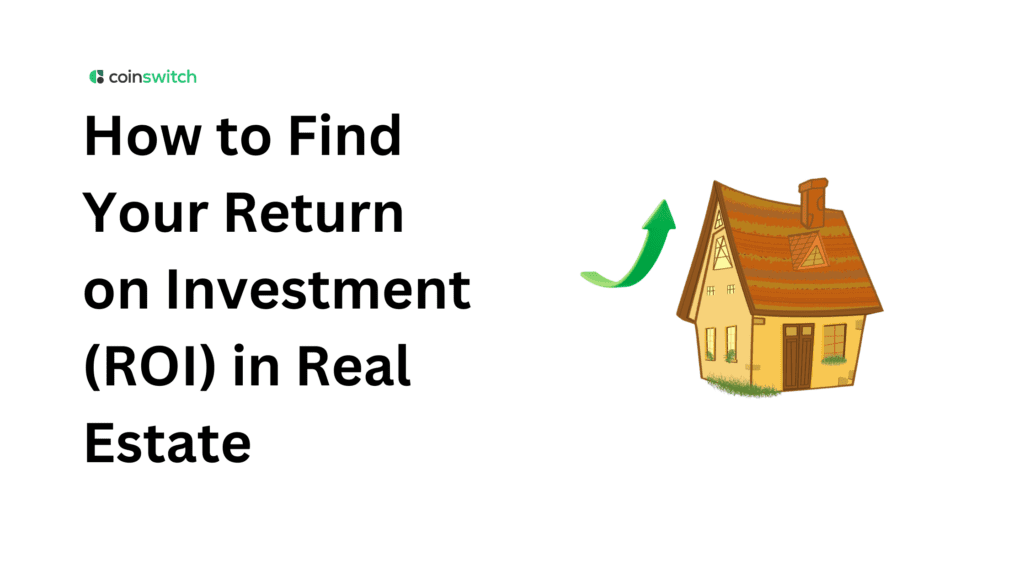Buying property for investment purposes can be tricky, as it is challenging to assess the returns you will earn accurately. The only way to measure it cleanly is ROI, Return on Investment. ROI is that single number that answers the big question: Is this property really generating a return on investment?
For some investors, ROI is about flipping, buying a flat at ₹50 lakh and selling it two years later for ₹70 lakh. For others, ROI is about achieving a rental yield of ₹30,000 per month and watching the returns accumulate year after year. Whatever the play, ROI is the report card. And in real estate, no investor should ignore that score.
Two Ways to Calculate Your Return on Investment
You can’t talk ROI without formulas, but don’t worry, they are pretty straightforward. Two main approaches dominate: simple ROI and cash-on-cash ROI.
The Simple ROI Formula
This one measures the profit you make when you sell.
ROI = (Profit ÷ Total Investment) × 100
Example:
- Buy at ₹60 lakh
- Spend ₹5 lakh on renovation
- Sell at ₹80 lakh
- Profit = ₹15 lakh
- Total investment = ₹65 lakh
- ROI = (15 ÷ 65) × 100 = 23%
That’s not a hypothetical number; that’s a story many investors dream of. Buy smart, add value, sell higher.
ROI on Rental Income (Cash-on-Cash Return)
This method is significant if you’re renting. It focuses on the actual amount you invested, ignoring what the bank financed.
Cash-on-Cash ROI = (Annual Net Rental Income ÷ Cash Invested) × 100
Suppose:
- Total Rental Income: ₹3,60,000)
- Expenses: ₹60,000 (maintenance, taxes, repairs)
- Net rental income = ₹3 lakh
- Cash invested = ₹20 lakh (down payment + fees)
- ROI = (3 ÷ 20) × 100 = 15%
That’s the number landlords live by. Forget the full property value. Ask: “What is my cash giving me back?”
Read More: What is an NFT? Non-Fungible Tokens Explained
Factors That Affect ROI
ROI isn’t carved in stone. It bends and shifts with real-world factors. Sometimes a property that looks like a gold mine on paper turns into a cash drain. Here’s what changes the game:
Location
Location writes the ROI story before you even buy. A 2BHK in Bandra West may cost ₹3 crore and give you ₹60,000 rent, yield under 3%. A flat in Pune’s Hinjewadi might cost ₹80 lakh and rent for ₹35,000, yielding over 5%.
One screams prestige. The other quietly pumps income. ROI doesn’t care about glamour. It cares about numbers.
Property Condition
An older house may come cheap, but it may bleed money in plumbing, wiring, and constant maintenance. A brand-new tower in Bengaluru might attract premium tenants at higher rents with fewer headaches. ROI rewards properties that hold value and keep costs down.
Financing
Borrowed money changes ROI fast. A low-interest home loan can actually boost cash-on-cash ROI because your initial investment is smaller. But a high EMI drains monthly rental profits. Investors who skip this math often wonder why their returns “feel smaller.”
Occupancy
An empty house makes zero income. Two months of vacancy equals a 16% drop in yearly rent. That’s why location and tenant quality matter as much as property price. ROI loves steady tenants.
Market Trends
Government policy, new infrastructure, or economic booms all ripple into ROI. A metro station nearby? Rents rise. A builder stuck in litigation? ROI collapses.
Read More: Treasure NFT: Scam or Legit Opportunity?
Real Estate Categories
Not all property is built equal. Each type of real estate comes with its own ROI character.
Residential Real Estate
Flats, villas, and independent homes. These dominate Indian portfolios. Typical rental yield: 2–5%. Add appreciation over 5–10 years, and ROI becomes compelling. For middle-class investors, residential property is the first ROI classroom.
Commercial Properties
Office spaces, IT parks, retail stores. Ticket sizes are larger, but yields of 8–12% are common. Vacancies, however, last longer. One wrong tenant can freeze ROI for months.
Industrial and Warehousing
Logistics hubs are ROI powerhouses. E-commerce has driven warehouse demand sky-high. Some deliver 12–20% returns. The leases are longer, too, 3 to 9 years. That stability helps ROI remain predictable.
Land Investments
Land has no rent. ROI here depends entirely on appreciation. Buy a plot on the outskirts of Hyderabad today, wait for an IT hub to sprout, and in 8 years, the ROI can multiply tenfold. Risky? Yes. Rewarding? Hugely, when it clicks.
What Is a Good Real Estate ROI?
Ask 10 investors and you’ll get 10 answers. For some, a “good” ROI is anything above a fixed deposit’s 7%. For others, it must outperform the stock market’s 12–15% return.
But broadly:
- Residential: 7–10% ROI is considered healthy
- Commercial: 10–15% ROI signals strength
- Exceptional assets: 15%+ ROI is gold, but rare
ROI isn’t just about numbers, though. A smooth 9% with minimal stress can be far more valuable than a chaotic 18% that eats your time and peace of mind.
An Alternative: REITs
Not every real estate investor wants tenants calling about a leaking pipe. Enter REITs, Real Estate Investment Trusts. These are listed on stock exchanges. You buy units, and the trust invests in office spaces, malls, or warehouses. You get dividends from the rent and potential capital gains on the units.
- Dividend yields: 6–8%
- Entry ticket: as little as ₹10,000
- Benefits: diversification, liquidity, and zero maintenance headaches
They don’t carry the thrill of owning property, but they give access to real estate ROI without the chaos of direct ownership.
Costs That Can Reduce Your ROI
ROI looks shiny on paper until you subtract the hidden costs. Here’s what usually eats into returns:
- Registration and Stamp Duty: Adds 5–8% to the purchase cost.
- Brokerage: 1–2% upfront.
- Maintenance Charges: Higher in luxury complexes.
- Loan Interest: The biggest ROI killer is if EMIs outweigh rent.
- Vacancy: Every empty month hurts ROI. Always plan for it.
- Renovation: Painting, plumbing, and upgrades eat into profits if not managed wisely.
Smart investors include these in their math from day one.
Explain Like I’m Five
Think of real estate like a mango tree. You buy the tree for ₹1,000. Every year, it gives you mangoes worth ₹100. That’s a 10% ROI. If you later sell the tree for ₹1,500, you also pocket an extra ₹500. Now your ROI is mango income plus resale profit.
That’s property in a nutshell. Rent is your mango. Appreciation is your resale. ROI is the math that tells you what you actually gained.
Conclusion
ROI isn’t fancy finance jargon. It’s the sharpest tool an investor can use. It tells you whether your property is generating returns or just appearing good on paper.
Track ROI on every deal. Compare it with FDs, mutual funds, and REITs. Don’t ignore costs. Don’t assume appreciation will save you. ROI keeps you grounded.
A good ROI makes your money work while you sleep. A weak ROI drains your time and capital. Use it like a compass in real estate. Keep checking it, and you’ll always know if your path leads to profit.
FAQs
1. What is the average return on real estate investment?
In India, residential property usually delivers 2–5% rental yield per year, plus long-term appreciation. Commercial assets tend to return 6–12% annually through rent. If you blend rent with appreciation, investors often see 8–12% ROI on average, though this varies by city, property type, and timing.
2. What does a 24% ROI mean?
A 24% ROI means your property earned 24 rupees of profit for every 100 rupees invested. If you put in ₹10 lakh, a 24% ROI equals ₹2.4 lakh in net returns. That’s a very strong number in real estate, usually seen in flips, undervalued buys, or highly profitable commercial deals.
3. What is the 2% rule?
The 2% rule is a quick test rental investors use. It says your monthly rent should equal 2% of the property’s purchase price. For example, a flat bought at ₹40 lakh should ideally rent for ₹80,000 a month to meet the 2% rule. In India, very few markets meet this, but the rule helps investors check if rent covers costs and produces a healthy ROI.
4. Is 20% ROI realistic?
A 20% ROI is rare in traditional residential real estate but can happen in specific situations: flipping a property after renovation, investing in warehousing or commercial units, or catching early growth zones before prices surge. For most investors, a consistent 8–12% ROI is realistic. A 20% ROI usually means higher risk, shorter timelines, or unusual market conditions.








